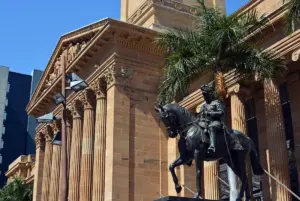Heritage Buildings To Visit In Queensland & Brisbane
Beyond its beaches, reefs, and rainforests, Queensland is also home to a wealth of historic architecture. From the colonial-era edifices of Brisbane to far-flung outback courthouses, many heritage buildings provide a window into early Queensland life.
Through restoration and preservation, the most iconic of these architectural survivors allow visitors to step back in time. Their diversity of styles stems from Queensland’s frontier origins, early settler ambitions, and later cultural fusions.
Beyond just standalone monuments, many retain their original purpose as homes, banks, museums, and galleries.
In this article, we will explore seven highlights spanning the breadth of the state’s architectural heritage, describing its history, design features, and significance today.
Table of Contents
Toggle
Brisbane City Hall
Sitting majestically on King George Square in the heart of Brisbane’s CBD is the Brisbane City Hall. Completed in 1930 after 10 years of construction, this sandstone building serves as the central municipal building for the City of Brisbane.
It was designed by the architecture firm Hall and Prentice to house the city’s local government offices while also providing cultural facilities. The City Hall’s grand exterior combines classical and baroque architectural styles.
Sandstone features include symmetrical arched colonnades, elaborate urns and balustrades, and a central 92-metre clock tower. The building’s predominant heritage value, though, lies in its grand interior spaces.
The Main Auditorium is considered one of Australia’s finest concert venues and seats more than 1500 under ornate plasterwork ceilings. The endearing Albert Organ was built in 1913 with nearly 5000 pipes added over time.
Beneath the building, the basement was home to Brisbane’s first public swimming pool within the ornate arches of the City Hall Concert Hall.
Visitors can take free guided tours to admire the beautiful heritage features. Concerts, performances, meetings, and functions are still hosted in the spaces added specifically for public enjoyment back in the 1930s.
The Brisbane City Hall remains an outstanding and widely loved example of interwar architecture.

Queensland National Bank, Childers
The small town of Childers in Queensland’s Bundaberg region is home to a strikingly ornate historic bank building. Built in 1902 for the Queensland National Bank, this single-story masonry building features elaborate Spanish Mission styling.
Designed by prominent architect F.G. Costello, the Childers branch uses contrasting brickwork to create decorative patterns across the façade. Face brickwork in red, brown, and purple hues provides color and texture, complemented by contrasting rendered bands.
Ornate parapets, arched windows and doorways, and a loggia with elaborate archways and columns add to the visual interest.
The building operated as a bank until 1981, when the Queensland National Bank was taken over. Restored in the 1990s, today it contains a café, art gallery, and visitor center.
Beyond just its own architecture though, the former bank building also represents the prosperity of the Isis Scrub district in the sugar boom of the early 20th century.

Nindooinbah Homestead
Tucked into the rim of the World Heritage-listed Lake Conjola near Beaudesert lies the extravagant Nindooinbah Homestead. Built-in the 1870s as the country estate of politician Henry Albert, Nindooinbah Station was an expansive cattle property spanning 100,000 acres.
The decorative Gothic-inspired homestead features grand verandahs, soaring arches, elaborate timber fretwork, and a central dome over the staircase. The beautiful deck ideas to make this one was something special.
The single-story manor house was designed by architect James Cowlishaw and built from local cedar. Outside lies a cottage, meat house, coach house, stables, and outbuildings for staff and servants.
Nindooinbah provides an intimate look into lavish country life for wealthy 19th-century cattle barons.
Tours allow you to view the historic furnishings, family photographs, and stories of the Albert family’s life on this grand bushland estate. Nindooinbah remains a working cattle property, with just a small portion opened to visitors.
Lightning Ridge Post Office
In the hot and dusty Australian outback mining town of Lightning Ridge lies a highly unique 1910 post office. What makes the Lightning Ridge Post Office special is that it was constructed entirely from corrugated iron.
This practical and economical choice of building material reflects the frontier nature of the outpost in the 1910s.
The simple structure consists of iron walls, roofing, and even decorative lacework touches. An awning above the doorway is propped up by poles. Out front stands the original postbox, still in use today.
Taken over by Australia Post in 1968, the corrugated post office has operated continuously for over 100 years. Today, it features postal history displays and serves as a museum commemorating the iconic opal mining settlement of Lightning Ridge.
The post office provides a fascinating lens into the isolation, struggle, and innovations of outback residents and miners in early 20th-century Australia.
Government House, Brisbane
Sitting high on a hill overlooking the Brisbane River, the Queensland Government House is an iconic landmark. Built between 1860 and 1910, this imposing white stone manor has served as the official residence for Queensland’s governors since 1909.
The mansion was designed in a Classical Revival style by colonial architect Charles Tiffin, featuring symmetric Georgian façades, colonnaded verandahs, and a striking central belvedere tower. Sandstone was locally sourced, with the exterior rendered white. Intricate iron lacework adorns the inner façade.
Inside, the grand staterooms reflect the colonial-era style, with marble fireplaces, crystal chandeliers, and Australian red cedar joinery.
The Opulent Ballroom, added in the 1890s, is lined with silk wallpaper depicting the seasons. Manicured gardens complement the stately architecture.
Visitors can take a free guided tour to appreciate Government House’s heritage features and learn about vice-regal life over the past century. Today it remains the official residence of Queensland’s Governor and is also used for hosting foreign dignitaries and diplomatic functions.

Maryborough Military and Colonial Museum
The former School of Arts in Maryborough now serves as an extensive museum and one of the town’s architectural gems. Built in 1908, the Federation-era building features arched colonnades, sandstone walls, leadlight windows, and a curved corrugated iron roof.
Inside, the museum’s collection provides insights into Maryborough’s history as a port, manufacturing hub, and major military base. Intricate displays cover colonial life, the defense forces, shipping, and Maryborough’s firearm manufacturing legacy.
The historic building itself is also a highlight, with original features including the jarrah floorboards and honor rolls of local soldiers.
Bulmba-ja Arts Centre, Cairns
On the waterfront in Cairns lies the Aboriginal-owned Bulmba-ja Arts Centre, located within the heritage-listed former Cairns Court House. Built in 1884-1886, the Court House is one of only three 19th-century public stone buildings remaining in Cairns.
This single-story brick complex showcases Victorian-era design with its colonnaded verandahs, arched windows, and multi-paned doors. Saved from demolition in the 1970s, today half the historic complex operates as an Indigenous-run arts center.
Visitors can browse and purchase artworks or take a cultural tour to learn about the history. The heritage architecture provides a stately backdrop, linking to Cairns’ frontier past.
Conclusion
From Brisbane’s seat of power to an outback post office made entirely from tin, these five heritage icons provide a spectrum of Queensland history and architecture.
Their stories reflect rural prosperity, political ambitions, gold fever dreams, and the ingenuity required to survive in remote frontiers.
The diversity of styles stems from Queensland’s colonial origins and development into the 20th century. Their preservation allows a precious glimpse into the past for locals and visitors alike.




